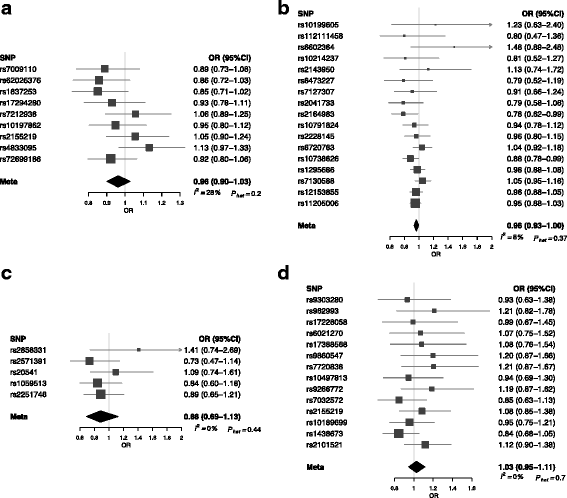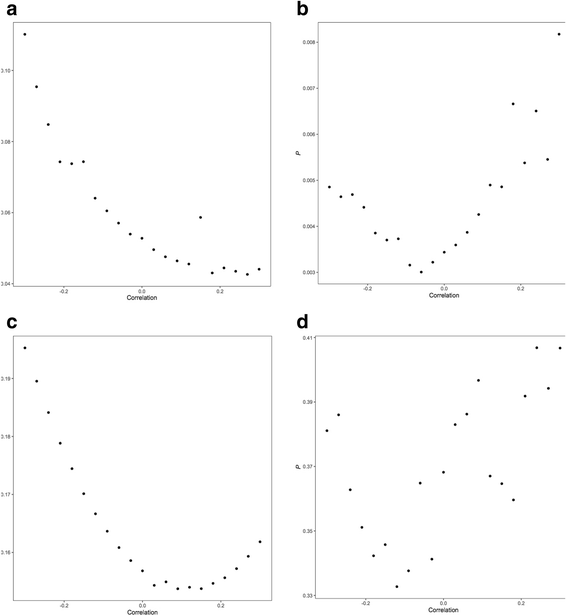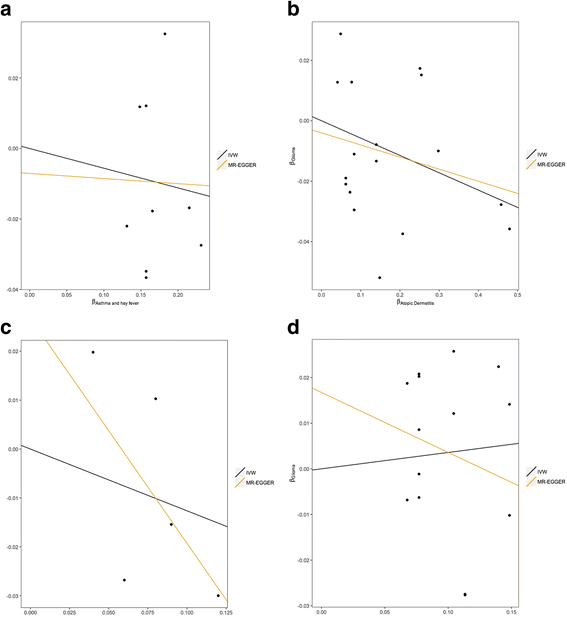Impact of atopy on risk of glioma: a Mendelian randomisation study
- PMID: 29540232
- PMCID: PMC5853158
- DOI: 10.1186/s12916-018-1027-5
Impact of atopy on risk of glioma: a Mendelian randomisation study
Abstract
Background: An inverse relationship between allergies with glioma risk has been reported in several but not all epidemiological observational studies. We performed an analysis of genetic variants associated with atopy to assess the relationship with glioma risk using Mendelian randomisation (MR), an approach unaffected by biases from temporal variability and reverse causation that might have affected earlier investigations.
Methods: Two-sample MR was undertaken using genome-wide association study data. We used single nucleotide polymorphisms (SNPs) associated with atopic dermatitis, asthma and hay fever, IgE levels, and self-reported allergy as instrumental variables. We calculated MR estimates for the odds ratio (OR) for each risk factor with glioma using SNP-glioma estimates from 12,488 cases and 18,169 controls, using inverse-variance weighting (IVW), maximum likelihood estimation (MLE), weighted median estimate (WME) and mode-based estimate (MBE) methods. Violation of MR assumptions due to directional pleiotropy were sought using MR-Egger regression and HEIDI-outlier analysis.
Results: Under IVW, MLE, WME and MBE methods, associations between glioma risk with asthma and hay fever, self-reported allergy and IgE levels were non-significant. An inverse relationship between atopic dermatitis and glioma risk was found by IVW (OR 0.96, 95% confidence interval (CI) 0.93-1.00, P = 0.041) and MLE (OR 0.96, 95% CI 0.94-0.99, P = 0.003), but not by WME (OR 0.96, 95% CI 0.91-1.01, P = 0.114) or MBE (OR 0.97, 95% CI 0.92-1.02, P = 0.194).
Conclusions: Our investigation does not provide strong evidence for relationship between atopy and the risk of developing glioma, but findings do not preclude a small effect in relation to atopic dermatitis. Our analysis also serves to illustrate the value of using several MR methods to derive robust conclusions.
Keywords: Allergy; Cancer; Glioma; Mendelian randomisation; Risk.
Conflict of interest statement
Ethics approval and consent to participate
Two-sample Mendelian randomisation was undertaken using GWAS data. Ethical approval was not sought for this specific project because all data came from the summary statistics of published GWAS, and no individual-level data were used.
Consent for publication
Not applicable.
Competing interests
The authors declare that they have no competing interests.
Publisher’s Note
Springer Nature remains neutral with regard to jurisdictional claims in published maps and institutional affiliations.
Figures



Similar articles
-
Plasma lipids, alcohol intake frequency and risk of Osteoarthritis: a Mendelian randomization study.BMC Public Health. 2023 Jul 11;23(1):1327. doi: 10.1186/s12889-023-16250-1. BMC Public Health. 2023. PMID: 37434151 Free PMC article.
-
Mendelian randomisation study of the relationship between vitamin D and risk of glioma.Sci Rep. 2018 Feb 5;8(1):2339. doi: 10.1038/s41598-018-20844-w. Sci Rep. 2018. PMID: 29402980 Free PMC article.
-
Genetic predisposition to smoking is associated with risk of rheumatoid arthritis: a Mendelian randomization study.Arthritis Res Ther. 2020 Mar 6;22(1):44. doi: 10.1186/s13075-020-2134-1. Arthritis Res Ther. 2020. PMID: 32143697 Free PMC article.
-
Association Between Atopic Dermatitis and Major Cardiovascular Outcomes: a Two-Sample Mendelian Randomization Study.Dermatol Pract Concept. 2022 Oct 1;12(4):e2022165. doi: 10.5826/dpc.1204a165. eCollection 2022 Nov. Dermatol Pract Concept. 2022. PMID: 36534570 Free PMC article. Review.
-
Genetic predisposition to COVID-19 may increase the risk of hypertension disorders in pregnancy: A two-sample Mendelian randomization study.Pregnancy Hypertens. 2021 Dec;26:17-23. doi: 10.1016/j.preghy.2021.08.112. Epub 2021 Aug 19. Pregnancy Hypertens. 2021. PMID: 34428710 Review.
Cited by
-
Epidemiology of Brain and Other CNS Tumors.Curr Neurol Neurosci Rep. 2021 Nov 24;21(12):68. doi: 10.1007/s11910-021-01152-9. Curr Neurol Neurosci Rep. 2021. PMID: 34817716 Free PMC article. Review.
-
Impact of Sex Hormones on Glioblastoma: Sex-Related Differences and Neuroradiological Insights.Life (Basel). 2024 Nov 21;14(12):1523. doi: 10.3390/life14121523. Life (Basel). 2024. PMID: 39768232 Free PMC article. Review.
-
Genetic predisposition to altered blood cell homeostasis is associated with glioma risk and survival.medRxiv [Preprint]. 2023 Oct 16:2023.10.15.23296448. doi: 10.1101/2023.10.15.23296448. medRxiv. 2023. Update in: Nat Commun. 2025 Jan 14;16(1):658. doi: 10.1038/s41467-025-55919-6. PMID: 37905116 Free PMC article. Updated. Preprint.
-
Glioma.Nat Rev Dis Primers. 2024 May 9;10(1):33. doi: 10.1038/s41572-024-00516-y. Nat Rev Dis Primers. 2024. PMID: 38724526 Review.
-
Risk factors for childhood and adult primary brain tumors.Neuro Oncol. 2019 Nov 4;21(11):1357-1375. doi: 10.1093/neuonc/noz123. Neuro Oncol. 2019. PMID: 31301133 Free PMC article. Review.
References
-
- Schlehofer B, Blettner M, Preston-Martin S, Niehoff D, Wahrendorf J, Arslan A, Ahlbom A, Choi WN, Giles GG, Howe GR, et al. Role of medical history in brain tumour development. Results from the international adult brain tumour study. Int J Cancer. 1999;82(2):155–160. doi: 10.1002/(SICI)1097-0215(19990719)82:2<155::AID-IJC1>3.0.CO;2-P. - DOI - PubMed
Publication types
MeSH terms
Grants and funding
LinkOut - more resources
Full Text Sources
Other Literature Sources

